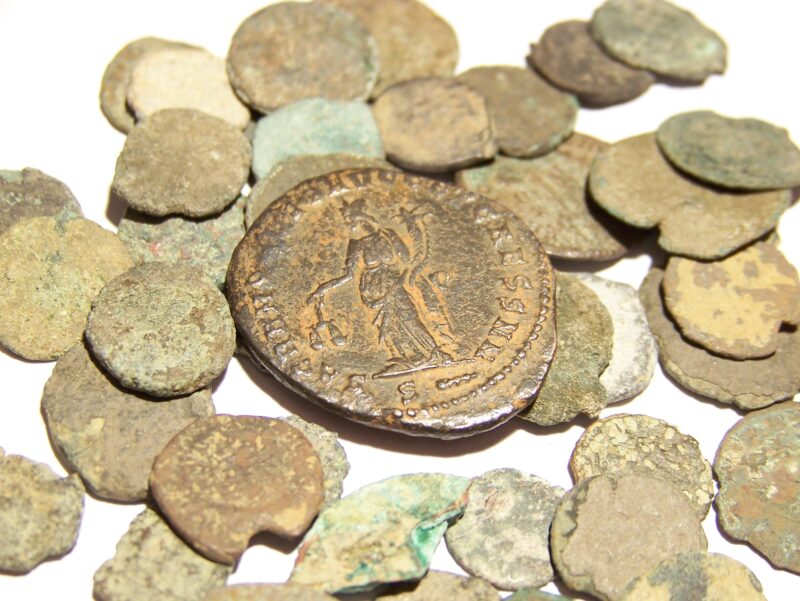When I learned history in school, I learned, like everyone else, the history I was supposed to learn, so the truth remained in the dark for me until many years later.
In the coming weeks, I will take you on a journey through history. And we won’t be looking at the whole shebang from the perspective of the deeply broken education system, we won’t be talking about strategies in wars, or the writings of Martin Luther. We’re not going to look at how many ships went down at the Battle of Trafalgar, or when an Indian started worshipping the first cow. No, we are going to look at it from the direction that’s more forbidden than Hunter Biden’s laptop because the Empire won’t like the future it predicts: Money.
A SHORT HISTORY OF ROMAN CURRENCY
The Etruscans took over control of Latium in 600 BC. This persisted until Tarquin the Proud, the final king, was driven out in 509 BC, at which point the Roman Republic came into being. Of Aryan descent, the Etruscans established one of the most sophisticated civilizations of the time and constructed roads, temples, and numerous public buildings in Rome.
The cow was the first “currency” in ancient Rome. This was a barter system rather than actual money. Cattle were frequently employed as a form of commerce by ancient cultures. The nearly 3,000 animals kept, according to the Herakles and the Augean Stables tale, stood in for King Augeas’s treasure.
As time went on, the Romans began substituting irregular pieces of copper or metal for cattle. For each transaction, these lumps, known as aes rude (rough metal), were to be weighed.
Rome became one of the most opulent towns in the ancient world as trade increased. This prosperity was built upon uncoined copper, subsequently bronze, metal that was weighed using a set system of units. It was known as aes signatum (stamped metal) because the government had stamped it with an image such as a cow, eagle, elephant, or another animal. It was issued by the Roman Treasury in the shape of ingots measuring 3 1/2 pounds (1.6 kg) and had the complete backing of the state. These ingots were swapped out for discoidal, cast, leaded bronze coins known as aes grave around 289 BC. (heavy metal). They were paid into circulation by the state, and each was only of value insofar as the symbols on which its numbers were recorded. So, rather than being dependent on the metal composition, this currency was based on legislation. (although that content was standardized, and the coin did have some intrinsic value, unlike most coins today). This can be viewed as a pioneering instance of fiat money actually being used successfully for once.
The Romans experienced an unprecedented rise in both public and private wealth until 300 BC. The gain in land can be used to measure this. After the Second Latin War ended in 338 BC and the Etruscans were vanquished, the Roman Republic expanded from 2,135 square miles (5,525 square kilometers) to 10,350 square miles (26,805 square kilometers), or 20% of peninsular Italy. The population increased from 750,000 to one million as its land area grew, with 150,000 people residing in Rome.
The Senate and those referred to as Senatus Populusque Romanus forged a partnership. (SPQR, the Senate, and People of Rome). The political figures were well known for their thrift and integrity. There was no inflation, and the means of exchange were rigorously regulated in line with the growth in trade and population. The debt-bondage nexus, in which a free man provided his services as collateral for a loan plus interest and required that the debt be worked off in circumstances of non-payment, was abolished after Plebeian agitation by the lex Poetelia1 in 326 BC.
The aristocratic elite’s acquisition of the right to produce silver coins in 267 BC led to the destruction of the conventional monetary system. This transformation was exemplified by a nobleman who went to the Temple of Juno Moneta (from whom the word money is derived) and used the straightforward method of stamping a new value on the coins to increase the worth of a sack full of silver denarii to five times its original value. He thereby kept the very significant seigniorage difference for his own personal use.
The drachma, an early Roman silver coin, was based on a coin used in the Greek south of the peninsula. Later, the little and lighter denarius took its place. A quarter unit called the sestertius and a half denarius called the quinarius were also available. Even later, the victoriatus, which was slightly lighter than the denarius and possibly designed to assist trade with Rome’s Greek neighbors, was added to the system.
The Italian peninsula had very few silver deposits, so the Roman army had to be enlarged in order to conquer nations and obtain supplies. The Roman peasants, who had given the Republic food independence, were being conscripted into the army in greater and greater numbers. The production of crops, particularly grain, decreased, and latifundia, which were massive estates staffed by slaves, supplanted the peasant farms. North African wheat had to be imported as well.
The Social War was caused by disagreements between Rome and her Italic allies on the awarding of citizenship and enfranchisement. (90-89BC). Because they were treated like slaves, had no obligations, and had no loyalty to the state, the working-class citizens had become alienated from Roman society as a result of their lack of enfranchisement. They were prohibited from joining the army until the Second Punic War (218–201 BC). This is a prime illustration of a monetarized society. Despotism was growing, and the Republic was losing strength. Pirate activity grew to be a serious issue, with coastal raids, the looting of villas, and the kidnapping of tourists. Due to the lack of a police presence to preserve law and order, violence grew widespread and criminals and terrorists were active in Rome. These are the unavoidable results of a culture where the pursuit of wealth has replaced all other values.
The “elite” were also involved in political intrigue. Social instability and discontent among the impoverished, who were increasingly slaves from North Africa, were results of economic hardship. This upheaval culminated in Spartacus’ uprising in 73–71 BC. (The first and second revolts were in 135-132BC and in 104-100BC).
Now, it’s going to get a bit difficult. I am Jewish myself, so I ask you to kindly refrain from antisemitism here, but we cannot discuss the story of money without the Jews: Maccabee were the first recorded Jews to come to Rome in 161 BC. These ancient Roman Jews worked as artisans, peddlers, and business owners. They also engaged in money lending during their previous employment. They resided in separate apartments as a group. Furthermore, they were excluded from serving in the military and ruled themselves under their own rules.
Gnaeus Cornelius Scipio Hispanus drove out the Jews, who were not Roman citizens, in 139 BC because they were proselytizing, but they soon came back. Emperor Tiberius expelled 4,000 Jews who had been involved in scandals in 19 AD through a senatus consultum, but none of these expulsions were properly enforced, and their continued presence, particularly as usurers, would significantly contribute to the decline and fall of the Roman Empire.
“CAESAR WAS A TYRANT” — FACT-CHECKERS SAY.
In September 45BC, Caesar returned to Italy and discovered that the homeless population, who had been evicted from their homes by usurers and land monopolists, had taken over the streets and cities. The public granary had to provide food for 300,000 people every day. Usury was thriving, which had disastrous effects.
The main usurers were demanding interest rates as high as 48% annually.2
“The customs of that most criminal nation have gained such strength that they have now been received in all lands. The conquered have given laws to the conqueror. The conquered have given laws to the conqueror.” — Lucius Annaeus Seneca, Superstitione
The Optimates, which were centered on the nobility, the Senate, and the privileged few, and the Populares, who stood up for the people, were the two main political parties at the time. Caesar took charge of the latter.
Caesar was completely aware of the dangers of usury and how to avoid them. He recognized the fundamental truth that money is a national agent, created by law for a national purpose, and that no class of men should withhold it from circulation in order to cause panics, allowing speculators to advance interest rates or to purchase property at ruinous prices after such panic.
Caesar enacted the subsequent social reforms:
- Property was restored at substantially lower prices than those that prevailed before the civil war. (49-45BC).
- Numerous rent waivers were given.
- Numerous destitute residents and soldiers who had been discharged were established on allotments.
- Eighty thousand homeless families received free homes.
- The 123 to 225 denarii in soldiers’ salary was increased
- The corn dole was regulated.
- Rural communities gained the right to vote.
- The calendar’s confusion was eliminated by setting it to 365 1/4 days starting on 1 January 44BC.
These were his monetary reforms:
- The amount of state debt was instantly lowered by 25%.
- The government took over management of the mint from the usurers, known as patricians.
- Low-cost metal coins were produced as a medium of trade.
- It was decided that interest could not be charged at a rate more than 1% monthly.
- It was ruled that interest cannot be levied on interest and that the total interest charged can never be greater than the capital lent. (in duplumrule).
- To settle debt, slavery was abolished.
- Aristocrats were compelled to use rather than hoard their wealth.
The aristocracy and plutocrats who suddenly had severely limited access to their known “livelihood” were outraged by these limitations. They therefore conspired to murder Caesar, the hero of the people. Only four years after taking office, on that fatal morning of March 15, 44BC, he dismissed his military guard, who had hitherto been there at all times, and entered the Senate building. He was killed by 23 stab wounds while being surrounded by 60 conspirators, and left for history to portray him as a tyrant and potentially dangerous future dictator. I’m not saying he would not have become one, but that sure as hell was not the reason why he was assassinated. History ever since repeated itself.
The Romans adopted the gold standard in 27 BC, not long after Caesar’s passing (and subsequent deification), which had profound effects on the empire’s financial stability and ultimately contributed to its fall. Previously, throughout the Roman Republic, gold coins were only produced at times of extreme need, such as the Second Punic War or Lucius Cornelius Sulla’s campaign. The majority of the materials could only be obtained from the east because there weren’t many gold mines in Europe outside isolated regions like Wales, Transylvania, and Spain. This in turn necessitated a sizable and costly army, which started fighting constantly on the periphery of the empire. Sounds familiar?
An aureus, a gold coin, was used. The copper coins sestertius, dupondius, and as were also in use, along with the silver denarius. Due to the lack of a widely accepted medium of exchange, episodes of deflation were frequently brought on by the paucity of gold or commodity money. When the weight of the gold aureus was decreased from 122 to 72 grains in 13 BC, some alleviation was offered, and this weight remained the norm until 310 AD. Metals, however, continued to go eastward in order to pay for opulence, religious obligations, and usury. Over the course of a century, wear and tear also caused a loss of one-third of all coins in circulation.
Debasement of gold was not permitted since it was seen as a commodity. Emperor Constantine (r. 275–337 AD) personally commanded the execution of those who engaged in counterfeiting, as well as the burning of public minters. Money changers who failed to report a fake gold bezant (solidus) were promptly whipped, made slaves, and banished. The bezant that was in use in 1025 AD weighed 68 grains; therefore these laws applied to the 70 grain bezant, which was a little heavier.
THE CHURCH SEALS ROME’S FATE
Emperor Constantine instituted a tax that obliged the Christian church to give one-tenth of all income to charity, hastening the demise of the empire. Finally, between one-third and fifty percent of all lands and funds were in the Church’s hands. This concentration of wealth led to a notable shortage of currency. Even if there existed money, goods, and services were not exchanged or distributed. Instead of investing the tithed money in the local economy or donating it to philanthropic endeavors like the construction of hospitals, schools, and libraries, vast hoards of gold were amassed behind the 20 foot (6.1 m) high walls of the fortress city of Constantinople and the Vatican stronghold in Rome.
In its latter decades in the fifth and sixth centuries, the Roman Empire had evolved into a parasitic organism, passing through cyclical periods of inflation and deflation. Again: Sounds familiar? Economic devastation comes before political disaster. There being no industrial production, almost all food had to be imported, and usury was conducted on an unprecedented scale. The wealth of the Roman Empire, which did not belong to the Church, was kept by 2,000 Roman houses. The rest of the population was impoverished.
THE EMPIRE IS DYING
The Dark Ages began in 476 AD as a result of the collapse of the western part of the Roman Empire as a result of successive invasions by Vandals and Goths. The following century was marked by a painful deflationary slump. The Roman Empire had $1.8 billion in metallic currency at its peak, according to the United States Silver Commission of 1876, but by the end of the Dark Ages it had decreased to $200 million. Agriculture was only practiced for survival. Large sailboats disappeared because there was no trade. The economy stalled. Science, art, and the understanding of how to make cement were lost.
Concentrated riches, the absence of industrial mining reserves, and the massive inflow of non-White slaves, which led to a drop in the genetic worth of the country, were major contributors to the fall of the Roman Empire. Due to the continued reduction in Roman female fecundity, slaves outnumbered citizens five to one by the fourth century AD. The lack of an affordable circulating medium of money and the misconception that money should be a commodity were the two most significant economic factors. A dishonest economic system will therefore unavoidably aid the forces of disintegration, according to the economic lessons learned from the fall of Rome. A phony economic system is unsustainable for any civilization. The issuance of means of trade by the legal power of the state acting as the representatives of the people in perpetuity is vitally necessary for any society to operate and develop.
“Change is frightening. Especially to those in power.” as Isaac Asimov says in Foundation. And that is precisely why we are sinking with flags flying while our “leaders” stand smugly at the bow of the sinking ship and lead us to certain doom.













